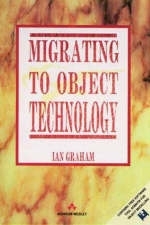
Migrating to Object Technology
Addison Wesley
978-0-201-59389-1 (ISBN)
- Titel ist leider vergriffen;
keine Neuauflage - Artikel merken
Given that many commercial organizations have decided to adopt object technology, practitioners are faced with the problem of how to get from where they are now to where they want to be, and must often work out a migration strategy which will protect their existing investments. The prime objective of this book is to present such a strategy. It is based on research into literature on object technology, but more importantly, on the author's own research and practical involvement with organizations facing exactly this migration problem in the context of specific projects. The book also contains additional material continuing on from Object Oriented Methods and takes a more detailed look at SOMA method of object-oriented analysis. As a guide to good practice, it places a strong emphasis on standards, following the existing and projected standards of the Object Management Group where applicable, and recommending others in areas such as expert systems and HCI.
1. The Need For ObjectTechnology The Adaptable Business The Productive Developer The Satisfied User OT as the Oly Trinity 2. Inter-Operation, Reuse And Migration Inter-Operation of Object-Oriented Systems with Conventional IT Data Management Strategies D> Practical Problems with Migration to Object Technology Reusing Existing Software Components and Packages Combining Relational and Object-Oriented Databases Wrappers for Expert Systems and Blackboard Systems Using Object-Oriented Analysis as a Springboard 3. Building Graphical User Interfaces The Need for GUIs GUI Tools and Languages Designing the HCI GUI Standards Multi-media Systems, Virtual Reality and Optical Storage Case Studies 4. Distributed Systems, Databases And Object Management Modeling Distributed Systems The Client/Server Model Distributed Databases and Full-Content Retrieval Collaborative Work, Work Flow Automation and Graphics Network and Architectural Issues Object Request Brokers and Distributed Objects Case Studies Difficulties in Implementing Distributed and Client/Server Systems Case Studies 5. Building Expert Systems Fundamentals of Expert Systems Knowledge Representation Inference in Knowledge Based Systems Fuzzy Rules and Fuzzy Objects Frames and Objects Script Theory Blackboard Architectures Fuzzy and Neural Systems Implementation in an Expert Systems Environment Part II Migration Using SOMA 6. Object Modeling Basic Philosophy What is an Object-Oriented Analysis Method? The OMG and Abstract Object Models The Models of Software Engineering Objects Layers Finding Objects Structures Responsibilities Rules and Rulesets State Model Notation D>Fuzzy Extensions Deliverables 7. Requirements Capture And Analysis Object-Oriented Analysis Methods The Requirements Capture Process Context Modeling and the Environment Model Task Analysis: Task-Scripts, Subscripts, Component Scripts and Side-Scripts Identifying Objects Building the Object Model Refining the Task-Scripts to Identify Responsibilities Creating Class Cards and Walking Through the System Objects with Complex States Setting Priorities and Running Object-Oriented RAD Workshops 8. Strategic Modeling And Business Process Re-Engineering Object-Oriented Enterprise Modeling The Zachman Framework Modeling and Re-Engineering the Business Business Policy and Fuzzy Models Deliverables 9. Life-Cycle What Must an Object-Oriented Model Do? Life-Cycle Models RADs, Time Boxes and Evolutionary Development The SOMA Process Model General Project Management Tasks Roles, Skills and Responsibilities Hacking as a Structured Activity 10. Metrices, Estimation And Testing Metrics, Measures and Models Estimation Techniques Metrics for Object-Oriented systems Analysis The SOMA Metrics Testing Techniques Quality Measurement 11. Coordination And Reuse Component Management and Reuse Class Libraries and Library Control The Process Environment and Rools Designing for Reuse Repositories and CASE Tools Cross-Project Coordination 12. Moving To Physical Design And Implementation Converting Rules to Assertions Specification as Implementation and the Benefits of Prototyping The Shift of the Breakpoint (Continuum of Not?) Modeling Systems Dynamics Use of Effect Correspondence Diagrams and Other Matrix Techniques Physical Design Implementation in an Object-Oriented Language Implementation in a Conventional Language Integration of Class Libraries Code Generation Formal Methods and Logic Deliverables 13. Case Studies SOMA in SOMA Migrating a Large Software Product Building a Trading System Building a Graphical user Interface A Process Model for Migration Standards
| Erscheint lt. Verlag | 8.12.1994 |
|---|---|
| Verlagsort | Boston |
| Sprache | englisch |
| Maße | 177 x 244 mm |
| Gewicht | 1089 g |
| Themenwelt | Informatik ► Software Entwicklung ► Objektorientierung |
| Mathematik / Informatik ► Informatik ► Theorie / Studium | |
| ISBN-10 | 0-201-59389-0 / 0201593890 |
| ISBN-13 | 978-0-201-59389-1 / 9780201593891 |
| Zustand | Neuware |
| Haben Sie eine Frage zum Produkt? |